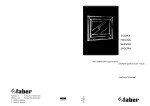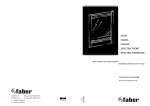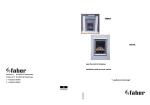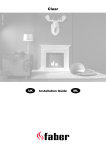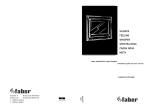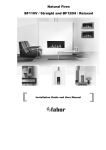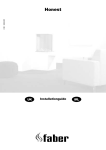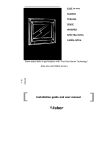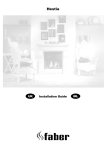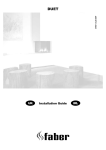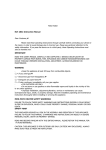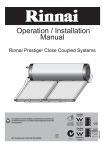Download installation guide and user manual free-standing gas fireplace
Transcript
VICO
free-standing gas fireplace
installation guide and user manual
“Log Burner Technology”
40 010 528
02 28
Saturnus 8
NL-8448 CC Heerenveen
Postbus 219
NL-8440 AE Heerenveen
T. +31(0)513 656500
F. +31(0)513 656501
UK/IRL
CONTENTS
1. INTRODUCTION
2
2. SAFETY INSTRUCTIONS
3
3. INSTALLATION REQUIREMENTS
3.1 Flue requirements
3.2 Terminal position
5
6
9
4. INSTALLATION-INSTRUCTIONS
4.1 Preparation of the appliance
4.2 Placing the appliance
4.3 Placing of the wood set
13
13
15
17
5. INSTALLATION OF THE FLUE
5.1 Connection of the flue
5.2 Remote control
5.3 Installation
18
18
19
20
6. COMMISIONING
6.1
6.2
6.3
6.4
22
22
22
23
23
Check pilot ignition
Functional burner checkr
Functional balanced flue check
Check reference pressure
7. HANDING OVER
24
8. SERVICING
8.1 Routine annual servicing
25
25
USER GUIDE
33
9. SAFETY INSTRUCTIONS FOR THE USER
34
10. CONTROLING THE APPLIANCE
36
11. CLEANING AND SERVICE INSTRUCTIONS
42
12. DISPOSAL OF THE PACKAGING AND THE APPLIANCE
43
INDEX 1
INDEX 2
LIST OF SPARE PARTS
TECHNICAL DATA
30
31
1
UK/IRL
UK/IRL
2. SAFETY AND GENERAL
1. INTRODUCTION
INFORMATION
Note: t h e s e i n s t r u c t i o n s s h o u l d b e r e a d c a r e f u l l y a n d r e t a i n e d f o r
future reference.
Please leave these instructions with the user.
Before installation, ensure that the local distribution conditions
(identification of the type of gas and pressure) and the adjustment of
the appliance are compatible.
Special features:
- Realistic flame and glow effect because of the "Log burner"
technology.
- Room sealed room appliance, inlet and outlet are led to the outside
using a natural draught concentric pipe system (100 mm/150 mm)
(no power fan required). No additional ventilation required.
- Air supply and flue-gases go to outside atmosphere through wall or
roof. A maximum horizontal extension of 6 meters is possible.
This gas appliance is factory set and shall not be adjusted by the
installer.
This appliance does not contain any component manufactured from
asbestos or any asbestos related products.
The pilot and flame sensing device fitted to this fire is also a safety
device. If for any reason any part of the pilot assembly is to be
replaced the entire assembly including the pilot burner, thermocouple,
electrode and injector must be exchanged complete for a pilot assembly
from the original manufacturer only.
- Remote Control option on all appliances.
- Meets the essential requirements of the European Gas Appliance
Directive (GAD) and carries the CE mark.
Ventilation
This appliance is room-sealed and doesn't require purpose provided
ventilation.
2.1 General safety
It is the law in the UK that all gas appliances, are installed by a
competent person in accordance with the Gas Safety (Installation and
Use) Regulations (as amended), the relevant British Standards for
Installation work, Building Regulations, Codes of Practice and the
manufacturers instructions.
The installation should also be carried out in accordance with the
following where relevant:
BS5871 Part1
BS5440 Parts 1 & 2
BS1251.
Building Regulations Document J (as applicable).
2
3
UK/IRL
UK/IRL
3. INSTALLATION REQUIREMENTS
Building Regulations and Standards issued as relevant by the
Department of the Environment or the Scottish Development Department.
Note:
Since the appliance is a source of heat, circulation of air occurs.
Therefore it is of importance that you do not use the appliance
shortly after a renovation of the home. Because of the natural
circulation of air, moist and volatile components from paint, building
materials, carpet etc. will be attracted. These components can settle
themselves down onto cold surfaces in the form of soot. As on all
heat producing appliances, soft furnishings such as blown vinyl
wallpaper placed to near to the appliance may become scorched or
discoloured. This should be born in mind when installing the
appliance.
In the Republic of Ireland installation should be carried out in
accordance with IS813, ICP3, IS327, Building Regulations, Codes of
Practice, the manufacturers instructions and any other rules in force.
Failure to comply with the above could leave the installer liable to
prosecution and invalidate the appliance warranty.
Safety instructions for the user: see chapter 9.
Dimensions:
For the dimsensions: see figure 1.
Minimum distance between the appliance and rear wall is 50 mm and
between appliance and sidewall min. 250 mm.
224
470
min.50
478
ø100
ø150
min.250
542
322
283
272
143
65.100
4
361
114.100
A-A
1115
1155
A
G3/8"
30
72
A
fig. 1
5
UK/IRL
UK/IRL
Flue restrictor
3.1 Flue requirements
The appliance is of the type C11/C31. The appliance will need to be
supplied with the approved flue pipes and terminal, it is not possible to
supply your own.
If applicable, in the table is also stated the size of a flue restrictor.
This restrictor needs to be fitted in the combustion chamber when
placing the appliance ( see chapter 4.2). Normally the smallest flue
restrictor is fitted.
The minimum effective height of the flue system must be 0.5 m.
Terminal locations, through the wall as well as through the roof. See
figure 3.
Flue routing;
- a horizontal extension with elbows is allowed for a maximum of 6
meter (depending on the type and situation).
- vertical max. 12 meter.
Determine on the base of the table 2 and 3, depending on the type
and terminal position, if the desired situation is possible.
To establish this you will need to calculate:
-The effective height (this is the real difference in height between the
upper side of the appliance and the terminal).
- The total horizontal extension. This is the total horizontal flue length
where:
• each elbow, which is in the horizontal area, counts for 2 meters.
• each 45-degree bend, which is in the horizontal area, counts for 1
meter.
• elbows and bends at the transition of horizontal to vertically are
not to be counted.
• the wall mounted terminal counts for 1 meter.
6
7
UK/IRL
UK/IRL
Horizontal extension
Example calculation 1:
2m
2m
Total horizontal extension
4m
Effective height
Flue lenght C + E = 1 + 1
Elbows
D = 1 x 2 mtr
Hvert.
Calculati0n horizontal extension fig. 2a:
Measure or calculate effective height
(Hvert)
G
Flue lenght A
Roof mounted terminal
1m
1m
Total effective height
2m
F
B
When calculating on basis of the table:
Allowed but without flue restrictor.
Remove the flue restrictor!
E
C
D
0
0,5
1
1,5
2
3
4
5
6
7
8
9
10
11
12
0
X
X
X
40
40
40
50
50
50
60
60
60
65
65
65
1
X
0
30
30
30
40
40
50
50
50
60
60
60
65
X
2
X
X
0
0
0
30
40
40
50
50
50
60
60
X
X
3
X
X
0
0
0
0
30
40
40
40
50
50
X
X
X
4
X
X
0
0
0
0
0
30
40
40
50
X
X
X
X
5
X
X
X
0
0
0
0
30
30
40
X
X
X
X
X
6
X
X
X
0
0
0
0
0
0
X
X
X
X
X
X
X combination
not allowed
0 remove flue restrictor
30 mm flue restrictor
45 mm flue restrictor
50 mm flue restrictor
60 mm flue restrictor
65 mm flue restrictor
A
fig. 3
Determine according to the table the right total horizontal- and vertical length.
When meeting an X, and when the values are outside the table, the combination is not
allowed.
3.2 Terminal position
fig. 2a
Example calculation 2:
Verify if the required terminal position meets the local installation
regulations regarding disturbance, good functioning and ventilation.
(Also see: safety requirements).
Flue lenght J + L = 0,5 + 0,5
Elbows
K + M = 2 x 2 mtr
Terminal
1m
4m
1m
Total horizontal extension
6m
Vertical
Flue lenght
1m
Hvert.
Calculati0n horizontal extension fig. 2b:
M
H
I
L
J
N
K
When calculating on basis of the table:
Combination not allowed.
Terminals located close to shared walkways, footpaths etc. could be
subject to legal constraints and this should be pointed out to the
customer before installation. If in any doubt about flue location
advice should be sought from local building control, or if appliancerelated, from the manufacturer including wherever possible a
dimensioned sketch.
H
8
Note:
The terminal must be located so that the outlet is not obstructed. If
the flue terminal is located within 2 meters of a footway, path or
where people could come into contact with it then a suitable terminal
guard must be fitted.
fig. 2b
9
UK/IRL
UK/IRL
3.2 Terminal position (continuing)
Avoid locating the terminal in close proximity to plastic materials
such as gutters or other combustibles. If this is unavoidable then a
suitable deflector should be made.
Table 4
Dimension Terminal position
A
Some important requirements for a good functioning are:
B
The wall-mounted terminal has to be at a distance of at least 0,5
meters off:
- Corners of the building.
- Below eaves.
- Balcony's etc. unless the duct is dragged to the front side of the
overhanging part.
C
The roof mounted terminal has to be at a distance of at least 0,5
meters of the sides of the roof, excluded the ridge.
D
E
F
G
H
I
J
K
L
Flue terminal positions
M
N
P
Q
10
(kW input 0-7 kW expressed in net)
Direct below an opening, airbrick,
opening windows, etc.
Above an opening, airbrick,
opening window ect.
Horizontally to an opening, airbrick,
opening window etc.
Below gutters, soil pipes or drain pipes
Below eaves
Below balconies or car port roof
From a vertical drain pipe or soil pipe
From an internal or external corner
Above ground roof or balcony level
From a surface facing the terminal
From a terminal facing the terminal
From an opening in the carport (e.g.
window) into the dwelling
Vertically from a terminal on the same wall
Horizontally from a terminal on the same wall
From a vertical structure on the roof
Above intersection with roof
Balanced flue room sealed
Natural draught
300 mm
300 mm
300 mm
500
500
600
300
600
300
600
600
1200
mm
mm
mm
mm
mm
mm
mm
mm
mm
1500
300
600
500
mm
mm
mm
mm
11
UK/IRL
UK/IRL
4. INSTRUCTIONS FOR INSTALLATION
Example of how terminal position is measured
4.1 Preparing the appliance
1. Locate the appliance in the right position, min distance 50 mm from
rear wall and 250 mm from a side wall.
2. Open the door by first loosening the locking screw in the door
handle, then pull down the handle (See fig. 4).
locking
A
A
fig. 4
12
13
UK/IRL
UK/IRL
4.1 Preparing the appliance (continuing)
4.2 Placing the appliance
3. Take the box with the log set out of the combustion chamber.
1.
4. Place the right flue restrictor in the combustion chamber. To
determine the right flue restrictor, see chapter 3.
2.
3.
4.
5.
6.
7.
Gas connection
- Installation pipes should be in accordance with BS 6891. Pipe work
from the meter to the appliance must be of adequate size.
- The complete installation including the meter must be tested for
soundness and purged as described in the above code.
- A means of isolation must be provide in the supply to facilitate
servicing.
- If applicable remove the receiver and disconnect the wires from
the gas valve
- Remove the cover plate (see fig 6). Unfasten the 4 screws on both
sides, hold the ash pen tray horizontal while removing the cover
plate.
- The connection should be made in 8 mm copper or similar semi
flexible tube (max. 1 meter). Ensure that the gas pipe does not
interfere with the removal or replacement of the burner tray of the
controls.
- The gas connection is nut and olive suitable for 8 mm pipe.
A
A
fig. 5
fig. 6
14
15
UK/IRL
UK/IRL
4.2 Placing the appliance (continuing)
4.3 Placing the log set
2. Points of attention for placement:
- Locate the appliance before assembling the flue.
- Painted flue pipes available.
- see also chapter 5 Flue installation
3. Check if the safety hatch on top of the combustion chamber is in
the right position and seals the combustion chamber properly (it
has to be air tight.)
fig. 8
On the bottom of the logs is a identification:
• 1 dimple
A
first log left placed over the burner and resting on the
burner tray.
• 2 dimples placed in the middle over he burner and resting on the
burner tray.
A
fig. 7
• 3 dimpels the right side log placed over the burner and resting on the
burner tray.
4. Place the log set (see placing log set, chapter 4.4).
5. Spread, the bags of embers (imitation ashes) provide with the
appliance over the burner tray. Attention! No embers under the logs
the logs have to rest on the burner tray!
6. Close the door and fixate the position of the handle by placing
back the screw in the door handle.
16
Never place extra elements of any kind into the combustion chamber.
To guarantee good combustion, the log set may only be installed in
the way specified by Faber International. Any other arrangement can
lead to soot on logs or window. Do not use the fire with broken or
missing logs.
17
UK/IRL
UK/IRL
5. INSTALLATION OF THE FLUE
5.1 Connections with use of concentric duct material
- There are painted flue sections available for the flue run in the
room.
- Build the system starting from the appliance on.
- Make a hole of ø 153 mm for the wall or roof mounted terminal.
- Make sure you place the pipes in the right direction, the narrow
end towards the appliance.
- Make sure the pipes are fixed sufficiently, a wall clamp every 2m, so
the weight of the pipes is not resting onto the appliance.
- The outside of the pipe can become hot (140 degrees). Stay 50 mm
away from wall surface or sealing. Make sure to provide sufficiently
heat resistant isolation when going through the wall or roof.
5.2 Remote control (if applicable)
The remote control is only meant to regulate the flames, it functions
only when the pilot burner is ignited. It is therefore not possible to
ignited the appliance with the remote control or to shut-off the pilotflame.
The radio-frequency remote control is intended for fireplaces installed
in a domestic setting in all EU countries except Austria, Denmark,
Finland and Greece.
Features:
- Manual control will always remain possible.
- The remote control is a radio frequency type and has been approved
internationally.
- The remote control generates a unique safety code every time you
activate the transmitter, its similar to those used in a car.
- The remote control is easy to install retrospectively.
- Because of expansion or cooling down the concentric pipes can turn
loose. It is recommended to fix the spring clip with a self tapping
screw at inaccessible places.
- To get the exact measure flue length you can use cut downconcentric pipe, wall mounted terminal or roof mounted terminal. To
obtain a smoke sealed connection, the inner pipe must be 20 mm
longer then the outside pipe.
- The horizontal pipes need to rise away from the appliance at a rate
of 3 degrees per metre.
18
19
UK/IRL
UK/IRL
5.3 Installation remote control
1. Connect the mains adapter to the receiver box. The adapter is set
to the correct voltage in the factory 4.5V.
Setting the right transmission code
The receiver has to learn the code from the transmitter, which is already
done at the factory. However the code disappears if the receiver is
disconnected from the mains for a longer period.
1. Set the on/off switch on the receiver to "on".
2. Push the "mod" button on the receiver and hold it for 3 seconds.
3. The green control lamp will light up and stay on. Repeat this step
if it doesn't.
fig. 9
4. Push a button on the remote control. The control lamp on the
receiver should now go out.
2. Slide the receiver box into the holder.
5. Again push a button on the remote control. The lamp starts
flashing and will switch off eventually.
3. Connect the wires to the gas valve (see fig. 10).
6. The receiver now recognizes the remote control. The remote
control now functions.
7. Check if you can hear a sound and the motor runs when you
push a button on the remote control.
fig. 10
4. Set the on/off switch on the receiver to "on".
20
21
UK/IRL
UK/IRL
6. COMMISSIONING
(functional checks)
6.1. Check pilot ignition
1. Push in and turn the control knob (A) from { anticlockwise to
the setting
(small flame). You will hear a tick meaning there is
ignition. Hold the knob in and wait for a few seconds while the air
is purged.
2. Bring the knob back in the start position and turn the knob several
times to the
position. Check that the pilot has lit.
3. Continue to hold in the control knob for a further ten seconds to
ensure that the pilot flame is stable.
4. Release the knob. The pilot should remain alight.
1. Set the appliance on max. input.
2. Verify the flame picture, this means no flames against the
window, the flame have to come besides the logs, if not check
the log layout.
3. Check if the flames are yellow after 10 minutes of operation. If
you still have a blue flame or the appliance goes out check:
- If the flue pipes are fitted correctly (no leakage).
- If the wall mounted terminal is placed with the correct side up.
- If the correct flue restrictor is installed.
B
B
B
D
C
D C
A
A
A
6.3 Functional balanced flue check
fig. 12
6.4 Check reference pressure
fig. 11
6.2 Functional burner check
1. Turn knob (B) to max. clockwise.
2. Turn the knob (A) more anticlockwise to the
position (large
flame). Now it is possible to light the main burner.
3. Turn knob B anticlockwise to max. The main burner should light.
Check for gas soundness at all joints with leak detection floud!
4. Check the ignition of the main burner on low and high setting.
5. Turn knob B clockwise till {. The main burner is off.
6. Turn the knob A to {. The pilot should go out.
22
The appliance is preset to give the correct heat input.
No further adjustment is necessary. Fit a pressure gauge at the test
point D to check the burner pressure.
The pressure should be checked with the appliance alight and at max
input.
The cold setting pressure should be as shown at the technical data
page 31.
After checking the pressure, turn off the appliance. Remove the
pressure gauge and close the sealing screw. Re-light the appliance.
Turn to max. input and test around the test point D for gas
soundness using a suitable leak detection fluid.
23
UK/IRL
UK/IRL
7. HANDING OVER
8. SERVICING
(final check and customer briefing)
7.1
Instruct the customer on the full operation of the appliance.
7.2.1 Advise the customer how to clean the appliance including the
glass.
It is recommended, that the fire is inspected/serviced by a competent
person at least once a year.
7.2.2 Instruct the customer on the operation of the remote control,
including replacement of batteries and how to set the right
transmissions code.
Important
Turn off the gas supply before commencing any servicing. Always test
for gas soundness after refitting the appliance .
7.2.3 Hand over these instructions including the user guide to the
consumer.
7.2.4 Recommend that the appliance should be serviced by a
competent person at least once a year.
24
To ensure safe, efficient operation of the appliance, it is necessary to
carry out routine servicing at regular intervals.
8.1 Routine annual servicing
1. Clean (if necessary):
- the pilot system;
- the burner;
- the combustion chamber;
- the glass.
2. Check the log lay and replace the embers (if applicable).
3. Do the functional test as described at page 22.
4. Check the flue system and terminal on damage and soundness
(visual inspection).
25
UK/IRL
UK/IRL
8.1.1 Cleaning the glass
Depending on the intensity of use , you can get a deposit on the
glass. This can be removed with a special ceramic glass cleaner
(ceramic cook-top cleaner) as follows:
1. Open the door as described at 4.1.
2. Clean the glass. Handle the glass with clean hands, wear
gloves, if possible try to avoid fingerprints on the glass.
3. Close the door and fixate the door handle.
8.2. Burner tray assembly
1. Open the door and remove remote control, log set, grid and burner
tray cover.
2. Remove the cover plate (see fig 6). Unfasten the 4 screws on both
sides, hold the ash pen tray horizontal while removing the cover
plate.
3. Break the gas supply at the 8mm connection inside the appliance.
4. Unscrew the burner assembly and take them out of the combustion
chamber.
B
Attention: Before closing the door : check the sealing rope is in good
condition. Be sure that there are no fingerprints on the glass. It is
not possible to remove those prints after you burn the appliance for
a while (they are burnt in).
A
C
D
8.1.2 Cleaning the combustion chamber
Remove the logs before cleaning.
Clean the combustion chamber with a vacuum cleaner.
If the burner is visibly damaged, replace the burner.
E
A.
B.
C.
D.
E.
26
fig. 13
Pilot assembly
Burner
Fixation plate
Injector
Gas control
27
UK/IRL
UK/IRL
8.3 Combustion test
Gas control block
A
B
C
D
Governor
Adjusting screw pilot flame
Inlet pressure test point
Burner pressure test point
A BS7967 combustion analysis check should be carried out using an
analyser to BS7927 positioned in the flue outlet.
A Ratio of CO/CO2 should be less than 0.01 within 30 minutes.
(100ppm CO per 1% CO2).
A reading of CO in the room centre should give a rise of less than
9ppm over ambient, peak reading.
B
A
A
B
D
D C
C
fig. 14
Propane conversion
For conversion from propane to natural gas, order for a propane
burner unit.
Please give the serial number from the data plate when you order.
28
29
UK/IRL
UK/IRL
LIST OF SPARE PARTS
Description
Glass
Burner NG
Burner propane
Log set
Receiver
Remote control
Adapter
Motor (remote control)
Gas control NG
Spark wire
Spark electrode
Pilot burner assembly NG
Thermocouple
Pilot burner assembly propane
Embers
Lack-spray for combustion chamber
Lack-spray other parts
TECHNICAL DATA
VICO
Company part
04508600
20523305
20523335
20786120
20604000
20603900
20900142
37003086
37003089
06017300
06006600
20900145
37002033
20900154
20900019
09000008
09000012
VICO
Country
Category
UK/IRL
II2H3+
UK/IRL
II2H3+
Appliance type
C11 / C31
C11 / C31
Reference gas
Input (nett)
Efficiency class
kW
G20
7,1
2
G30/G3
6,9
2
Inlet pressure
mbar
20
30/37
Gas Rate 15 °C / 1013 mbar
m3/h
0.75
0.215 or 0.5 kg
Reference burner pressure
mbar
12
23
Injector size
mm
3x 1.5
3x 0.9
Reduced input restrictor
mm
2.1
1.1
SIT 160
Nr 51
SIT 160
Nr 30
100-150 mm
30
100-150 mm
30
GV36-C5AOEHC68M
GV36-C5AODHC68M
230VAC/50HZ/5VA
4.5
2 x LR03
Alkaline long life
230VAC/50HZ/5VA
4.5
2 x LR03
Alkaline long life
8 mm nut and olive
8 mm nut and olive
Pilot assembly
Type
Code
Flue system
MV size
Pre installed flue restrictor
mm
Gas control
Remote control
Adapter
Voltage adapter
Batteries remote control
Gas connection
V
Dimensions: see figure 1
30
31
UK/IRL
UK/IRL
USER GUIDE
32
33
UK/IRL
UK/IRL
9. SAFETY INSTRUCTIONS FOR THE
USER
9.1 General safety instructions
If a gas leak is found or suspected, turn off the gas supply at the meter
and contact your installer or gas emergency service.
These instructions should be read carefully and retained for future
reference.
Do not use the fire with a broken or damaged glass.
The fire has a safety device which turns off the gas supply if there is a
build up from flue gasses in the combustion room or a temporary gas
cut-off. Wait at least 5 minutes before turning the appliance on again.
Contact a qualified installer when the appliance goes off regularly.
The appliance has been designed for heating purposes. This means that
all surfaces, including the glass, can become very warm (over 100
degrees). An exception to this is the lower side of the door and the
control buttons.
IMPORTANT
A suitable Fireguard conforming to BS6539 and BS6778 should be used
with this appliance to protect children, the elderly or infirm. Care
should also be taken with pets.
In your own interest and that of safety, all gas appliances must be
installed by competent persons. Installation must be in accordance with
National Regulations. CORGI registered installers are required to work to
recognised standards.
Note:
Since the appliance is a source of heat, circulation of air occurs.
Therefore it is of importance that you do not use the appliance shortly
after a renovation of the home. Because of the natural circulation of air,
moist and volatile components from paint, building materials, carpet etc.
will be attracted. These components can settle themselves down onto
cold surfaces in the form of soot. As on all heat producing appliances,
soft furnishings such as blown vinyl wallpaper placed too near to the
appliance may become scorched or discoloured. This should be born in
mind when installing the appliance.
Due to the newness of materials, they may give off a slight smell for a
period after initial lighting. This is normal, odours will disperse after a
few hours use.
Do not place curtains, clothing, laundry, furniture or other flammable
materials nearby the appliance. The required minimum distance is
100 cm.
Switch off the receiver of the remote control if you don’t use the fire for
a long time. Do not let children use the remote control without
supervision.
34
35
UK/IRL
UK/IRL
10. CONTROLLING THE APPLIANCE
Once gas is available at the pilot, continued rotation anti-clockwise
will cause the piezo igniter to spark. This is accompanied by a click
at the valve and should result in the pilot burner igniting.
Once the pilot is lit, the control knob should be held pressed in for
10 seconds. In this time the pilot flame will have heated the flame
supervision thermocouple sufficiently to operate a hold-on magnet
within the valve.
Now turn the control knob A to the
position. This allows gas to
enter control knob B.
10.1 Lighting the fire
If the main burner or pilot light are extinguished for any reason, do
not attempt to relight the pilot within 5 minutes. Contact a qualified
installer when the appliance goes off regularly.
The gas valve is behind the ashtray door, open by pulling down.
Knob B
The { is the OFF position preventing gas entering the main burner if
the pilot is lit.
The knob should be turned slowly anticlockwise. This allows gas to
enter the burner and be ignited by the pilot flame. Once ignition has
taken place, the fire may be set to any level between min. and max. by
adjusting the control knob B.
With control button A you can light the pilot. With the control button
B you can adjust the height of the flames (see fig. 15).
A
B
10.2 To light
1. Push in and turn the control knob (A) from { anticlockwise to
the setting
(small flame). You will hear a ignition click. Check
that the pilot is lit (if not repeat).
2. Continue to hold in the control knob for a further ten seconds to
ensure that the pilot flame is stable.
fig. 15 gas valve
Knob A
4. Turn the control knob A to the
The { is the OFF position preventing any gas from passing through the
control valve to either the pilot burner or to the main burner. By
pressing the knob in it is possible to turn it anticlockwise. The first
function is to turn on the gas to the pilot- this occurs just before
reaching the |position (if the fire has not been lit for some time it may
be necessary to hold the knob in this position for some seconds to
clear the air from the pipe and allow gas to reach the pilot burner).
36
3. Release the knob. The pilot should remain alight.
position.
5. Turn knob B slowly anticlockwise, the fire should then ignite.
6. Adjust flames to the required level.
37
UK/IRL
UK/IRL
10.3 To extinguish
10.4.1 To light
1. Push in and turn the control knob (A) from { anticlockwise to
the setting (small flame). You will hear a ignition click. Check
that the pilot is lit (if not repeat).
1. For the main burner turn the control knob B clockwise to
position {.
2. To disable knob B turn knob A to the
position.
2. Continue to hold in the control knob for a further ten seconds to
ensure that the pilot flame is stable.
3. To extinguish the pilot turn control knob A to position { ,
although it is in order lo leave the pilot permanently lit.
3. Release the knob. The pilot should remain alight.
10.3.1 When the pilot extinguishes
4. Turn the control knob A to the
Warning! When the pilot extinguishes, for whatever reason, you should
wait at least 5 minutes before trying to turn it on again.
5. Set the on/off switch on the receiver to "on”.
Possible causes of pilot extinguish are:
- Operating error.
- Interference of the safety device.
- Failure in the pilot flame system.
low flame
high flame
6. Use
(high) and
flame effect.
Contact a qualified installer when the appliance goes off regularly.
10.4 Remote control
fig. 16
remote control
The remote control is only meant to regulate the flames from off till
max., it functions only when the pilot burner is ignited and knob A in
(big flame) position. It is therefore not possible to ignite the pilot
flame with the remote control or to extinguish the pilot flame. The
radio-frequency remote control is intended for fireplaces installed in a
domestic setting in all EU countries except Austria, Denmark, Finland
and Greece.
Features:
- Manual control will always remain possible.
- The remote control is a radio frequency type and had been approved
internationally.
- The remote control generates a unique safety code every time you
activate the transmitter, its similar to those used in a car.
- The remote control is easy to install retrospectively.
38
position.
(low) to achieve the desired heating and
7. You will hear a beep every time the receiver recognises a good
signal. (If not, so see 10.4.3, setting the right transmission code).
8. When the fire is not be used for a prolonged period, turn off the
pilot (see 10.4.2).
10.4.2 To extinguish
1. Push
(low) till the burner goes out and you can hear the motor
clicking.
2. To enable the remote control turn knob A to the
position.
3. To extinguish the pilot turn control knob A to position {, although
it is in order to leave the pilot permanently lit.
39
UK/IRL
UK/IRL
10.4.3 Setting the right transmission code
10.4.4 Changing the batteries
The receiver has to learn the code from the transmitter, which is already
done at the factory. However the code disappears if the receiver is
disconnected from the mains for a longer period,
There is no risk of electric shock as the low voltage supply is similar
to that used in torches. Always turn off the appliance before changing
batteries.
Remote control
1. Set the on/off switch on the receiver to "on".
1. Remove the cover on the back of the remote control.
2. Push the "mod" button on the receiver and hold it for 3 seconds.
2. Carefully remove the battery clip along the side. Pay attention not
to pull the wires.
3. The green control lamp will light up and stay on. Repeat this step
if it doesn't..
4. Push a button on the remote control. The control lamp on the
receiver should now go out.
5. Again push a button on the remote control. The lamp starts
flashing and will switch off eventually.
4. Click the battery clip into the remote control and close the cover.
AAA
AAA
+
3. If necessary, remove the old batteries and place the new ones: 2 x
LR03 Alkaline long life 1.5 V.
5. It might be possible that you have to set the transmission code
after changing the batteries (see 10.4.3).
+
6. The receiver now recognizes the remote control. The remote
control now functions.
Note
Batteries are chemical waste and should be disposed in accordance
with local regulations.
7. Check if you can hear a sound and the motor runs when you
push a button on the remote control.
fig. 17
changing batteries
40
41
UK/IRL
UK/IRL
11. CLEANING AND SERVICE
INSTRUCTIONS
Important:
Turn off the fire and allow it to cool down before
commencing cleaning.
It is recommended that the fire is inspected/serviced, by a competent
person at least once a year.
To maintain the finish on the trim wipe with soft damp cloth only. Do
not use abrasive cleaners, polish or solvents as these can damage
the surface finish.
12. DISPOSAL OF THE PACKAGING
AND THE APPLIANCE
The appliance packaging is recyclable. The packaging could include
the following materials:
- cardboard;
- CFC-free foam (soft);
- wood;
- plastic;
- paper.
These materials should be disposed responsibly and in conformity
with government regulations.
Batteries are considered chemical waste. The batteries should be
disposed of responsibly and in conformity with government
regulations. Remove the batteries before disposing of the remote
control.
Information on how to responsibly dispose of discarded appliances
can be obtained from the local authorities.
42
43
























